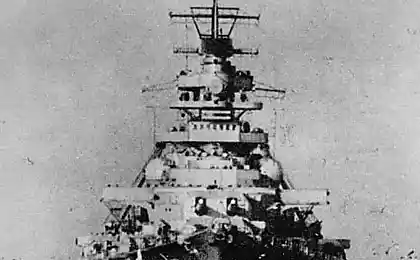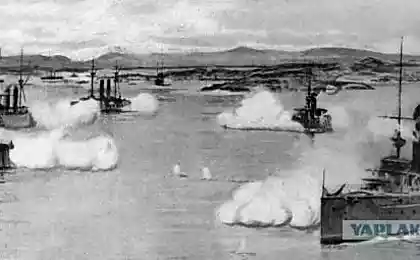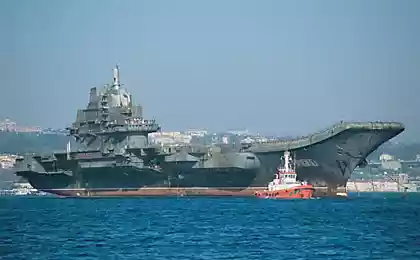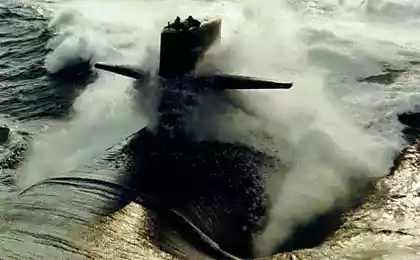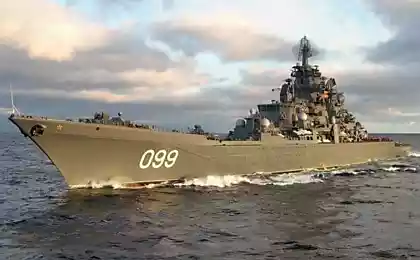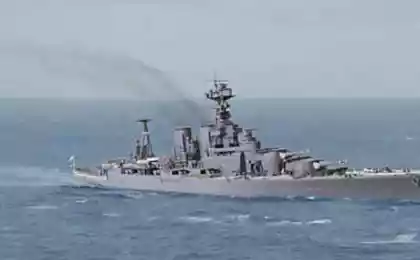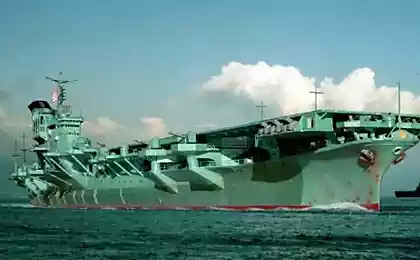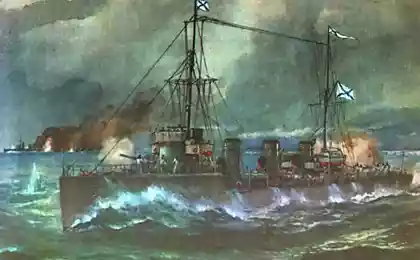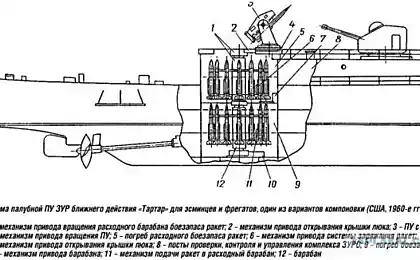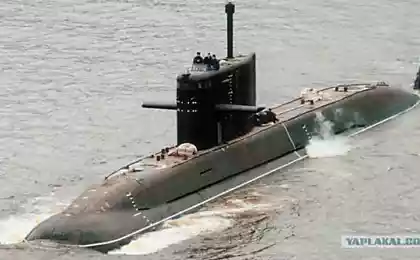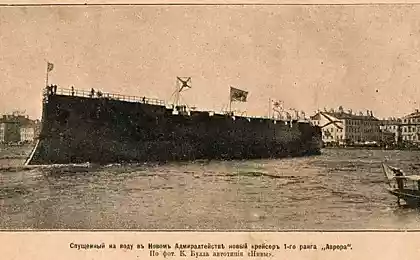3180
Heavy cruiser "Prinz Eugen" (12 photos)
When all the people want to make it better, the Germans are doing it right. They have an exceptional tendency towards idealism and barbaric distortion achieved idealism.
It is difficult to write about the fascist victory weapons, but, fortunately, do not have to. Heavy cruisers of the "Admiral Hipper" were questionable in everything extremely complicated, expensive, high-tech equipment overwhelmed, with very poorly protected than any of its rivals.
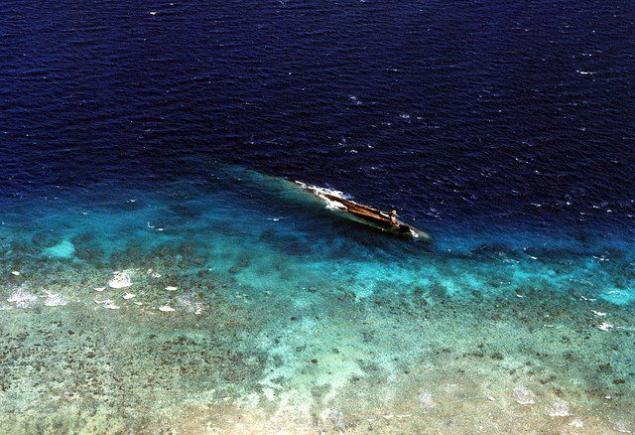
Anomalous on manning for ships of this class (1400-1600 sailors + extra specialists, which took on board during the campaign).
Capricious steam turbine power plant.
Modest by the standards adopted in its class - quality, versatile, but without any frills.
Struck by the fact that, unlike other countries, the Third Reich was spared the hard "Washington" restrictions, sets the bar standard displacement cruisers at around 10 thousand. Tons. Nevertheless, the result was doubtful. Even in the absence of strict limits (in standard / and German cruisers - more than 14 thousand. Tons) and the presence of a highly developed industry, the Germans built a mediocre ships, which have become a formidable prophecy for the future generations.
Ideas of the "hipper": "electronics - above all", "flexibility and multi-tasking", "advanced detection and fire control - to the detriment of the traditional protection and firepower" - one way or another, consistent with trends in modern shipbuilding.
However, even in this form, using primitive technology 70 years ago, "hipper" favorably differed from modern "cans" by the presence of body armor and its highest survivability.
There have been five, "Admiral Hipper", "Blucher", "Prinz Eugen", "Seydlitz" (converted into an aircraft carrier, undeveloped) and "Lutzow" (sold to the Soviet Union when ready 70% undeveloped).
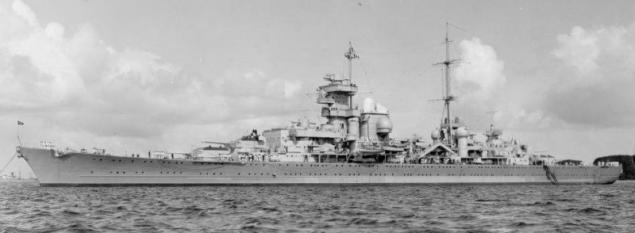
The most famous "Prinz Eugen" - the only one of the German heavy ships, who lived to the end of the war. Undermining a mine on the bottom, falling bombs, torpedo attack, severe accident navigation, raids Soviet and British aircraft - cruiser stubbornly "licking" the wound and continued on his way to battle.
And then in the sky flashed a second sun, a second illuminating Bikini Atoll unbearable light. When all was quiet on the surface of the lagoon is still rocking bulk cruiser "Prinz Eugen". Did not help, and the second, an underwater explosion "Baker" - German ship was stronger than the nuclear fire!
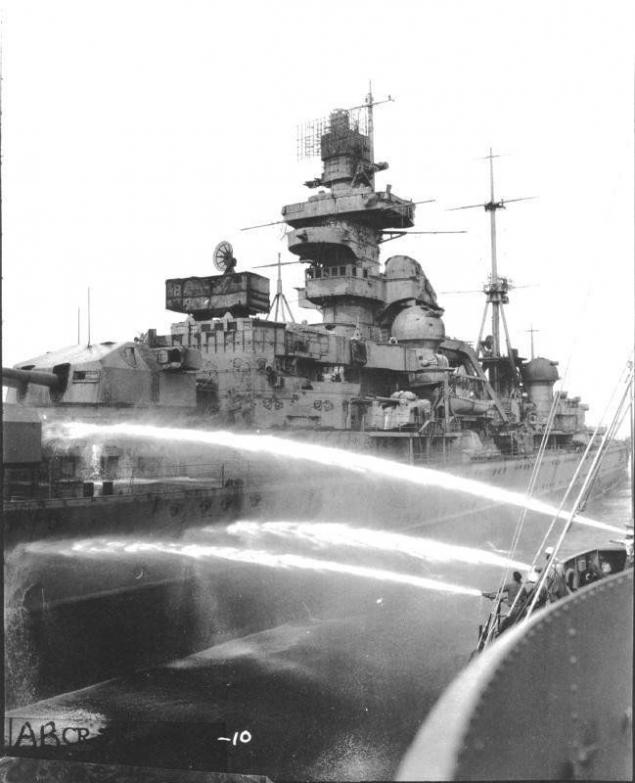
Decontamination
Heavy cruiser "Prinz Eugen" was a true legend - a monumental silhouette, the crew of the best volunteers Kriegsmarine and active military career throughout the war.
Cruiser immortalized his name by taking part in the battle in the Denmark Strait (the sinking of the battle cruiser "Hood"). In contrast to the "Bismarck", "Prince" managed to escape retaliation by the British Navy and return safely to base. Then there was a daring jump from Brest to Germany, short and dull Norwegian Cruise Service to close the Baltic Sea. At the end of the war, "Prinz Eugen" shot five thousand. Shells at the advancing Soviet troops and fled to Copenhagen. After the war, the United States went on reparations.
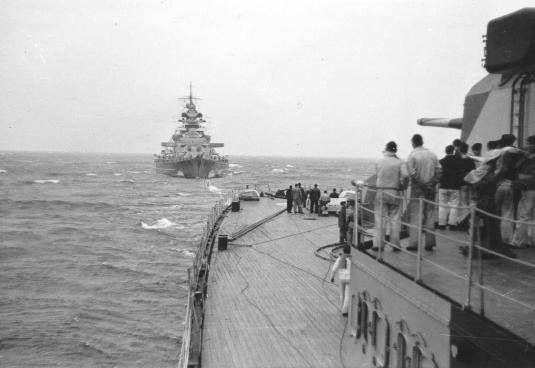
In the wake of the "Prince" - terrible "Bismarck»
During his military career, "Prince" is not sunk any enemy ship, but gained a lot of moral victories over the enemy - which is his breakthrough across the Channel, under the noses of the entire British air and naval forces of His Majesty.
Was it the right decision about the construction of this monster, or 109 million. Reichsmarks could be better spent - this rhetoric has the wrong message. Germany was doomed anyway.
The cruiser was built, fought without fear and without reproach, is draining a lot of enemy forces. Knocked down a dozen aircraft, damaged British destroyer received a commendation from ground units of the Waffen-SS.
Of course, during the construction of the cruiser, no one thought that it would be used as the "biggest gunboats of the Baltic Sea." "Prinz Eugen" was created as part of the fleet of Greater Germany, which, in the near future, to fight with Britain and the United States for control of the oceans!
But it happened anyway - Hitler gnawed vial of poison, and the only surviving cruiser Kriegsmarine was sent to the area of nuclear weapons tests.
Technical features
From their peers "Prinz Eugen" compared favorably perfect set of detection equipment (radar, infrared night vision systems, efficient sonar - the ability to distinguish not only enemy submarines, but even some torpedoes and mines in the water!).
Stabilized in three planes rangefinder command posts, analog computers, PJSC - all positions were duplicated, dispersed and protected by armor. Radio electronics continuously improved - in the field of detection and fire control "Prince" was not equal among the other "Europeans»!
The large number of bulky and lightweight avionics explains the need for multiple crew and such a high cost of the ship ("Prince" in comparable prices was 2, 5 times more expensive than the British TCR "County»).

Steam turbine power plant with capacity 133 600 hp provided a speed of about 32, 5 knots. At full of oil reserves (4,250 tons) cruising range cruiser was 5500 miles on the economic speed of 18 knots.
Armament "Prince" did not look so impressive against the backdrop of American and, especially, the Japanese cruisers:
- 8 guns of the main caliber (203 mm) in four towers - the mandatory minimum for the TCR of those years. For comparison, the standard for American TKR had nine 203 mm guns; for Japanese - 10;
- 12 universal instruments (105 mm) in six paired units - solid. By the number of heavy flak competition "Prince" could be only "Italians" and "Americans»;
- Small-caliber antiaircraft artillery: automatic cannon caliber 20 and 37 mm, including five quad installations Flak 38. In the autumn of 1944 anti-aircraft armament was strengthened by 40 mm anti-aircraft guns "Bofors". The overall verdict - yes, air defense cruiser was at a decent level.
- 4 triple-tube torpedo launchers, ammunition 12 torpedoes. On this parameter "Prince" surpassed only the Japanese with their "Long Lance". For comparison - British heavy cruisers carrying half the torpedoes, the US had no torpedoes.
- Air Group: pneumatic catapult, two under-deck hangar, up to five reconnaissance seaplanes "Arado-196».
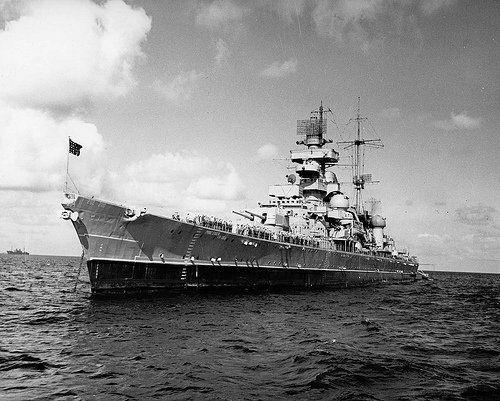
In general, the weapons "Prince" was typical of the era, but can cause a shock to the shipbuilders of the XXI century, accustomed to the compactness of modern launchers and below deck placement of weapons (which, of course, helps to improve the stability of the ship).
In contrast to the modern cell OHR, "Prinz Eugen" was forced to bear a powerful rotating tower, weighing from 249 ("A" and «D») to 262 tons («B» and «C»). And this is without taking into account barbet, mechanization cellars and ammunition supply system! Not less hassle brought universal artillery installation - each of them had a mass of 27 tonnes.
Old German cruiser - a mute reproach modern shipbuilders who are building high-tech "shells" that are killed by unexploded missiles.
The "Prince" in this sense was a full order - problems with its support (compared to peers) pales against the backdrop of the current situation, where only one close to a surface explosion that cost a billion dollars superkorabl. Completely worn out.
The Germans, it was different - they were able to cover every inch of armor warship!
In short, the scheme of reservation "Prince" was as follows:
From the 26th to the 164th frame stretched the main armor belt thickness of 80 mm and a height of 2, 75 to 3, 75 meters, which had a slope of 12, 5 ° outwards; overlap at the ends of the belt 80 mm armor abeam, located perpendicular to the center line of the ship.
In this book the body did not end - the stern was a thin belt 70 mm thick, equal to the height of the main b / n. On the sixth frames it closes 70 mm traverse bulkhead (German Navy conducted numbering frames from astern). Also covered the nose of the belt 40 mm (in the last three meters from the stem - 20 mm), while it had a greater height than the main b / n.
Horizontal protection system consisted of two armored decks:
- Bronepaluby top, 25 mm thick (over boiler section) and thin to 12 mm in the fore and aft of the ship;
- Main bronepaluby also extends over the entire length of the cruiser. Its thickness was 30 mm, only in the area of forage towers locally increased to 40 mm, and the bow is reduced to 20 mm. The deck is about 1 m below the top edge bronepoyasa and it slants connected with its lower edge.
Of course, that's not all - the cruiser had strong local reservation. Armor was covered most of the battle stations and facilities in the superstructure:
- Conning tower - 150 mm wall, roof 50 mm;
- Suspension bridge - 20 mm armor antifragmentation;
- Communication pipe with cables - 60 mm;
- Admiral's bridge, the main command post and ranging all the rooms below it - 20 mm;
- Chimneys above the armored deck - 20 mm.
Finally, the main fire barbettes towers (80 mm) and the protection of the towers themselves - from 160 mm (endplate) to 70 mm (side walls).
How true was the decision of German designers to perform a complete book of the ship?
The already small reserve load allocated for the installation of armor, it was exacerbated by "smearing" in the whole structure of the cruiser - what sense was the bow "bronepoyas" thickness of only 20 mm? For what it took to protect the chain locker and windlasses premises?
Here it is worth remembering that the Germans have designed their ships under the specific conditions of the Second World War naval artillery duel in which the critical speed play. Numerous shrapnel holes could trigger flooding forward compartments - thus leading to a "burying" the nose into the water and slow the cruiser with all the ensuing consequences.
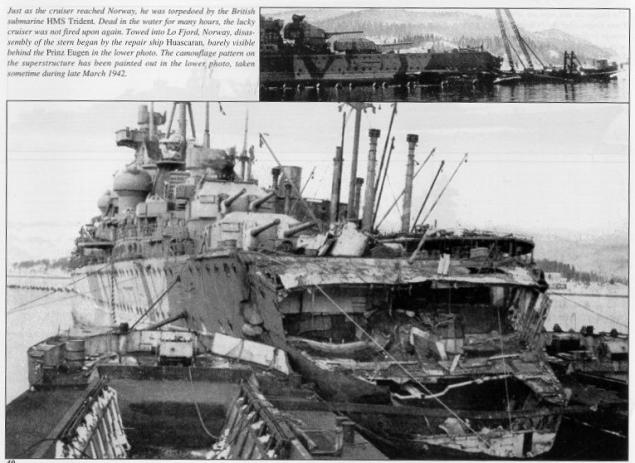
Result submarine torpedo hit with "Trident»
In general, the parameter "security", the German cruisers looked complete outsiders compared to other heavy cruisers of the era - the leader, of course, is the Italian "Zara" bronepoyasom with a thickness of 100 ... 150 mm horizontal and total protection 85 ... 90 mm!
However, both the German was not easy! Even so primitive horizontal protection (25 + 30 mm) was able to provide decent resistance to enemy air attacks.
For the first time "Prince" became acquainted with the destructive power of bombs a month before its official entry into service. July 2, 1940, he was hit by a British aircraft and was 227 kg "fugasku" in the area of the engine room LB.
Bomb, as expected, has broken through the upper armored deck and exploded in the cabin. The consequences of being as follows: hole in the deck with a diameter of 30 cm, dent 4x8 meters, hit the galley, chimney, electrical cables and bulkheads Kubrick. The upper deck was cleared up and broken motor boat, damaged catapult, boat crane, scratched one of the 105 mm guns. Out of order some fire control devices (from the direct effects of the explosion products or strong shaking body - the data on this subject are available).
However, the nature of the damage indicates that the bomb could not break through the main armor deck: engine rooms remained intact. Managed to avoid damage below the waterline. Preserved functional artillery chief and universal caliber. Armor saved the ship and its crew from serious consequences.
If the episode occurred on the high seas, heavy cruiser would keep running, electricity and most of its combat capability - which would continue to combat the problem (or return to base under its own power).

Rudder manually
Next hit bombs in the "Prinz Eugen" resulted in the whole detective story with an unexpected outcome. The plot is simple - a description of damage in the official Russian sources odds with common sense.
In 1942, during his imprisonment in Brest, cruiser once again subjected to raid British bombers. A series of six bombs "covered" order in which stood the "Prinz Eugen", while one of them - polubroneboynaya 500 funtovka - came directly to the ship. Shot hit the edge of the deck, at a distance of 0, 2 m from the left side. The bomb pierced the thin upper deck and with a terrible roar rushed down, tearing counter bulkhead. Gliding along the side cladding, it reached 30 mm bevel main bronepaluby, and, breaking another layer of armor, exploded in the lower areas.
The blast destroyed or partially damaged some rooms, the second floor and the bottom of the siding. Were flooded two compartments, one of which housed the power plant №3. Part of the units affected by splash damage. Mechanical installation damage had. Due to failure of the artillery post partially damaged artillery CC. Located at a distance of 5-8 meters from the center of the explosion of 203 mm and 105 mm charges cartridges were not injured. In the area of the explosion caused a fire that was quickly extinguished by personnel. Losses in the crew were more than 80 people.
- IM Korotkin "Battle damage to surface ships" (L.1960 g)
In general, awful - only one 227 kg bomb caused a fire, flood, pose a threat to the detonation of ammunition and led to the deaths of a large number of sailors. But is it actually was?
The first question is, how it was possible to avoid detonation b / c - when the explosion epicenter was only 5-8 meters from the cellar? It is terrible to imagine how would look like an explosion ... 50 100 kg powerful brizanta in a closed room! The shock wave and thousands of red-hot fragments have been demolished and the riddle all bulkheads within a few tens of meters (thickness bulkheads below the main bronepaluboy does not exceed 6-8 mm).
And if the risk of detonation shells from near the explosion looks unconvincing (they are almost impossible to activate without a fuse), the ignition of powder charges - a prerequisite in the situation described above.
If we assume that the bomb pierced the armor and did not explode - then what caused the death of 80 people?
Also, in serious doubt find such a large number of people in the main office and premises artillery ship generators - while standing in the dock when the power supply is carried out from the shore.
And finally, a mention of the sinking of two sections - which could not be the principle: it is known that "Prince" at that time was in the dock.
It seems that in a lack of primary sources, the author misinterpreted (or falsified) facts combat damage cruiser "Prinz Eugen».
According to the Russian researcher Oleg Teslenko, it happened much simpler: bomb failed to break the main bronepalubu and exploded in the cabin personnel. This explains the heavy losses among the crew and automatically removes the question of "miraculous escape" the powder magazine.
Thin 30 mm bronepaluba perfectly fulfilled its purpose, avoiding a much more serious consequences.
With regard to the serious damage in the inner rooms, and the death of many sailors - it is the wine of the German engineers who designed the ship with so little protection.
Heavy cruiser "Prinz Eugen" is a good example of a warship, designed as taking into account the traditional attributes of the ships of the past years (firepower, high speed, security), and taking into account a number of modern trends (multifunctionality, information technology, advanced detection and JMA).
German experience was not the best, but he proved the feasibility of such projects in practice. Each of the elements of the heavy cruiser was useful in real combat conditions. Only problem was that the Germans wanted too much from the ship that is based on technologies 30s.
It is not difficult to imagine what heights can be achieved today, 80 years after the laying of the cruiser "Prinz Eugen»!
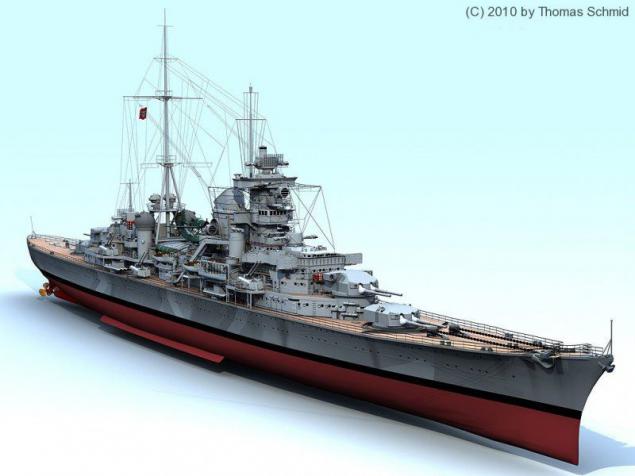
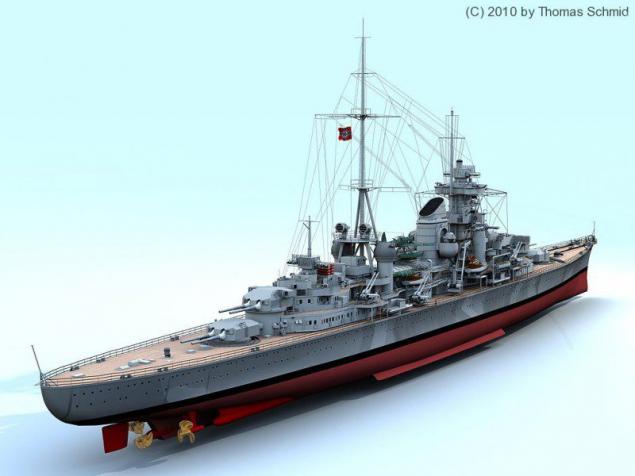
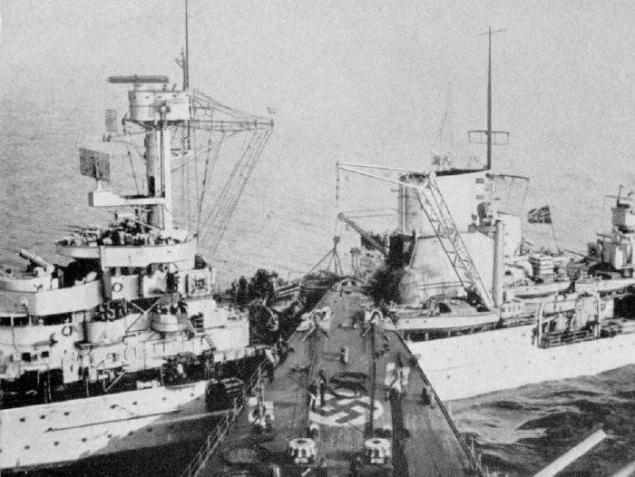
Clash of TCR "Prinz Eugen" with the light cruiser "Leipzig»

... By the time the steel case has become so radioactive that its deactivation in a few months it seems impossible. December 21 remaining pumps are no longer cope with the incoming water, the body tilted, and the windows were below the sea surface.
It is difficult to write about the fascist victory weapons, but, fortunately, do not have to. Heavy cruisers of the "Admiral Hipper" were questionable in everything extremely complicated, expensive, high-tech equipment overwhelmed, with very poorly protected than any of its rivals.

Anomalous on manning for ships of this class (1400-1600 sailors + extra specialists, which took on board during the campaign).
Capricious steam turbine power plant.
Modest by the standards adopted in its class - quality, versatile, but without any frills.
Struck by the fact that, unlike other countries, the Third Reich was spared the hard "Washington" restrictions, sets the bar standard displacement cruisers at around 10 thousand. Tons. Nevertheless, the result was doubtful. Even in the absence of strict limits (in standard / and German cruisers - more than 14 thousand. Tons) and the presence of a highly developed industry, the Germans built a mediocre ships, which have become a formidable prophecy for the future generations.
Ideas of the "hipper": "electronics - above all", "flexibility and multi-tasking", "advanced detection and fire control - to the detriment of the traditional protection and firepower" - one way or another, consistent with trends in modern shipbuilding.
However, even in this form, using primitive technology 70 years ago, "hipper" favorably differed from modern "cans" by the presence of body armor and its highest survivability.
There have been five, "Admiral Hipper", "Blucher", "Prinz Eugen", "Seydlitz" (converted into an aircraft carrier, undeveloped) and "Lutzow" (sold to the Soviet Union when ready 70% undeveloped).

The most famous "Prinz Eugen" - the only one of the German heavy ships, who lived to the end of the war. Undermining a mine on the bottom, falling bombs, torpedo attack, severe accident navigation, raids Soviet and British aircraft - cruiser stubbornly "licking" the wound and continued on his way to battle.
And then in the sky flashed a second sun, a second illuminating Bikini Atoll unbearable light. When all was quiet on the surface of the lagoon is still rocking bulk cruiser "Prinz Eugen". Did not help, and the second, an underwater explosion "Baker" - German ship was stronger than the nuclear fire!

Decontamination
Heavy cruiser "Prinz Eugen" was a true legend - a monumental silhouette, the crew of the best volunteers Kriegsmarine and active military career throughout the war.
Cruiser immortalized his name by taking part in the battle in the Denmark Strait (the sinking of the battle cruiser "Hood"). In contrast to the "Bismarck", "Prince" managed to escape retaliation by the British Navy and return safely to base. Then there was a daring jump from Brest to Germany, short and dull Norwegian Cruise Service to close the Baltic Sea. At the end of the war, "Prinz Eugen" shot five thousand. Shells at the advancing Soviet troops and fled to Copenhagen. After the war, the United States went on reparations.

In the wake of the "Prince" - terrible "Bismarck»
During his military career, "Prince" is not sunk any enemy ship, but gained a lot of moral victories over the enemy - which is his breakthrough across the Channel, under the noses of the entire British air and naval forces of His Majesty.
Was it the right decision about the construction of this monster, or 109 million. Reichsmarks could be better spent - this rhetoric has the wrong message. Germany was doomed anyway.
The cruiser was built, fought without fear and without reproach, is draining a lot of enemy forces. Knocked down a dozen aircraft, damaged British destroyer received a commendation from ground units of the Waffen-SS.
Of course, during the construction of the cruiser, no one thought that it would be used as the "biggest gunboats of the Baltic Sea." "Prinz Eugen" was created as part of the fleet of Greater Germany, which, in the near future, to fight with Britain and the United States for control of the oceans!
But it happened anyway - Hitler gnawed vial of poison, and the only surviving cruiser Kriegsmarine was sent to the area of nuclear weapons tests.
Technical features
From their peers "Prinz Eugen" compared favorably perfect set of detection equipment (radar, infrared night vision systems, efficient sonar - the ability to distinguish not only enemy submarines, but even some torpedoes and mines in the water!).
Stabilized in three planes rangefinder command posts, analog computers, PJSC - all positions were duplicated, dispersed and protected by armor. Radio electronics continuously improved - in the field of detection and fire control "Prince" was not equal among the other "Europeans»!
The large number of bulky and lightweight avionics explains the need for multiple crew and such a high cost of the ship ("Prince" in comparable prices was 2, 5 times more expensive than the British TCR "County»).

Steam turbine power plant with capacity 133 600 hp provided a speed of about 32, 5 knots. At full of oil reserves (4,250 tons) cruising range cruiser was 5500 miles on the economic speed of 18 knots.
Armament "Prince" did not look so impressive against the backdrop of American and, especially, the Japanese cruisers:
- 8 guns of the main caliber (203 mm) in four towers - the mandatory minimum for the TCR of those years. For comparison, the standard for American TKR had nine 203 mm guns; for Japanese - 10;
- 12 universal instruments (105 mm) in six paired units - solid. By the number of heavy flak competition "Prince" could be only "Italians" and "Americans»;
- Small-caliber antiaircraft artillery: automatic cannon caliber 20 and 37 mm, including five quad installations Flak 38. In the autumn of 1944 anti-aircraft armament was strengthened by 40 mm anti-aircraft guns "Bofors". The overall verdict - yes, air defense cruiser was at a decent level.
- 4 triple-tube torpedo launchers, ammunition 12 torpedoes. On this parameter "Prince" surpassed only the Japanese with their "Long Lance". For comparison - British heavy cruisers carrying half the torpedoes, the US had no torpedoes.
- Air Group: pneumatic catapult, two under-deck hangar, up to five reconnaissance seaplanes "Arado-196».

In general, the weapons "Prince" was typical of the era, but can cause a shock to the shipbuilders of the XXI century, accustomed to the compactness of modern launchers and below deck placement of weapons (which, of course, helps to improve the stability of the ship).
In contrast to the modern cell OHR, "Prinz Eugen" was forced to bear a powerful rotating tower, weighing from 249 ("A" and «D») to 262 tons («B» and «C»). And this is without taking into account barbet, mechanization cellars and ammunition supply system! Not less hassle brought universal artillery installation - each of them had a mass of 27 tonnes.
Old German cruiser - a mute reproach modern shipbuilders who are building high-tech "shells" that are killed by unexploded missiles.
The "Prince" in this sense was a full order - problems with its support (compared to peers) pales against the backdrop of the current situation, where only one close to a surface explosion that cost a billion dollars superkorabl. Completely worn out.
The Germans, it was different - they were able to cover every inch of armor warship!
In short, the scheme of reservation "Prince" was as follows:
From the 26th to the 164th frame stretched the main armor belt thickness of 80 mm and a height of 2, 75 to 3, 75 meters, which had a slope of 12, 5 ° outwards; overlap at the ends of the belt 80 mm armor abeam, located perpendicular to the center line of the ship.
In this book the body did not end - the stern was a thin belt 70 mm thick, equal to the height of the main b / n. On the sixth frames it closes 70 mm traverse bulkhead (German Navy conducted numbering frames from astern). Also covered the nose of the belt 40 mm (in the last three meters from the stem - 20 mm), while it had a greater height than the main b / n.
Horizontal protection system consisted of two armored decks:
- Bronepaluby top, 25 mm thick (over boiler section) and thin to 12 mm in the fore and aft of the ship;
- Main bronepaluby also extends over the entire length of the cruiser. Its thickness was 30 mm, only in the area of forage towers locally increased to 40 mm, and the bow is reduced to 20 mm. The deck is about 1 m below the top edge bronepoyasa and it slants connected with its lower edge.
Of course, that's not all - the cruiser had strong local reservation. Armor was covered most of the battle stations and facilities in the superstructure:
- Conning tower - 150 mm wall, roof 50 mm;
- Suspension bridge - 20 mm armor antifragmentation;
- Communication pipe with cables - 60 mm;
- Admiral's bridge, the main command post and ranging all the rooms below it - 20 mm;
- Chimneys above the armored deck - 20 mm.
Finally, the main fire barbettes towers (80 mm) and the protection of the towers themselves - from 160 mm (endplate) to 70 mm (side walls).
How true was the decision of German designers to perform a complete book of the ship?
The already small reserve load allocated for the installation of armor, it was exacerbated by "smearing" in the whole structure of the cruiser - what sense was the bow "bronepoyas" thickness of only 20 mm? For what it took to protect the chain locker and windlasses premises?
Here it is worth remembering that the Germans have designed their ships under the specific conditions of the Second World War naval artillery duel in which the critical speed play. Numerous shrapnel holes could trigger flooding forward compartments - thus leading to a "burying" the nose into the water and slow the cruiser with all the ensuing consequences.

Result submarine torpedo hit with "Trident»
In general, the parameter "security", the German cruisers looked complete outsiders compared to other heavy cruisers of the era - the leader, of course, is the Italian "Zara" bronepoyasom with a thickness of 100 ... 150 mm horizontal and total protection 85 ... 90 mm!
However, both the German was not easy! Even so primitive horizontal protection (25 + 30 mm) was able to provide decent resistance to enemy air attacks.
For the first time "Prince" became acquainted with the destructive power of bombs a month before its official entry into service. July 2, 1940, he was hit by a British aircraft and was 227 kg "fugasku" in the area of the engine room LB.
Bomb, as expected, has broken through the upper armored deck and exploded in the cabin. The consequences of being as follows: hole in the deck with a diameter of 30 cm, dent 4x8 meters, hit the galley, chimney, electrical cables and bulkheads Kubrick. The upper deck was cleared up and broken motor boat, damaged catapult, boat crane, scratched one of the 105 mm guns. Out of order some fire control devices (from the direct effects of the explosion products or strong shaking body - the data on this subject are available).
However, the nature of the damage indicates that the bomb could not break through the main armor deck: engine rooms remained intact. Managed to avoid damage below the waterline. Preserved functional artillery chief and universal caliber. Armor saved the ship and its crew from serious consequences.
If the episode occurred on the high seas, heavy cruiser would keep running, electricity and most of its combat capability - which would continue to combat the problem (or return to base under its own power).

Rudder manually
Next hit bombs in the "Prinz Eugen" resulted in the whole detective story with an unexpected outcome. The plot is simple - a description of damage in the official Russian sources odds with common sense.
In 1942, during his imprisonment in Brest, cruiser once again subjected to raid British bombers. A series of six bombs "covered" order in which stood the "Prinz Eugen", while one of them - polubroneboynaya 500 funtovka - came directly to the ship. Shot hit the edge of the deck, at a distance of 0, 2 m from the left side. The bomb pierced the thin upper deck and with a terrible roar rushed down, tearing counter bulkhead. Gliding along the side cladding, it reached 30 mm bevel main bronepaluby, and, breaking another layer of armor, exploded in the lower areas.
The blast destroyed or partially damaged some rooms, the second floor and the bottom of the siding. Were flooded two compartments, one of which housed the power plant №3. Part of the units affected by splash damage. Mechanical installation damage had. Due to failure of the artillery post partially damaged artillery CC. Located at a distance of 5-8 meters from the center of the explosion of 203 mm and 105 mm charges cartridges were not injured. In the area of the explosion caused a fire that was quickly extinguished by personnel. Losses in the crew were more than 80 people.
- IM Korotkin "Battle damage to surface ships" (L.1960 g)
In general, awful - only one 227 kg bomb caused a fire, flood, pose a threat to the detonation of ammunition and led to the deaths of a large number of sailors. But is it actually was?
The first question is, how it was possible to avoid detonation b / c - when the explosion epicenter was only 5-8 meters from the cellar? It is terrible to imagine how would look like an explosion ... 50 100 kg powerful brizanta in a closed room! The shock wave and thousands of red-hot fragments have been demolished and the riddle all bulkheads within a few tens of meters (thickness bulkheads below the main bronepaluboy does not exceed 6-8 mm).
And if the risk of detonation shells from near the explosion looks unconvincing (they are almost impossible to activate without a fuse), the ignition of powder charges - a prerequisite in the situation described above.
If we assume that the bomb pierced the armor and did not explode - then what caused the death of 80 people?
Also, in serious doubt find such a large number of people in the main office and premises artillery ship generators - while standing in the dock when the power supply is carried out from the shore.
And finally, a mention of the sinking of two sections - which could not be the principle: it is known that "Prince" at that time was in the dock.
It seems that in a lack of primary sources, the author misinterpreted (or falsified) facts combat damage cruiser "Prinz Eugen».
According to the Russian researcher Oleg Teslenko, it happened much simpler: bomb failed to break the main bronepalubu and exploded in the cabin personnel. This explains the heavy losses among the crew and automatically removes the question of "miraculous escape" the powder magazine.
Thin 30 mm bronepaluba perfectly fulfilled its purpose, avoiding a much more serious consequences.
With regard to the serious damage in the inner rooms, and the death of many sailors - it is the wine of the German engineers who designed the ship with so little protection.
Heavy cruiser "Prinz Eugen" is a good example of a warship, designed as taking into account the traditional attributes of the ships of the past years (firepower, high speed, security), and taking into account a number of modern trends (multifunctionality, information technology, advanced detection and JMA).
German experience was not the best, but he proved the feasibility of such projects in practice. Each of the elements of the heavy cruiser was useful in real combat conditions. Only problem was that the Germans wanted too much from the ship that is based on technologies 30s.
It is not difficult to imagine what heights can be achieved today, 80 years after the laying of the cruiser "Prinz Eugen»!



Clash of TCR "Prinz Eugen" with the light cruiser "Leipzig»

... By the time the steel case has become so radioactive that its deactivation in a few months it seems impossible. December 21 remaining pumps are no longer cope with the incoming water, the body tilted, and the windows were below the sea surface.
